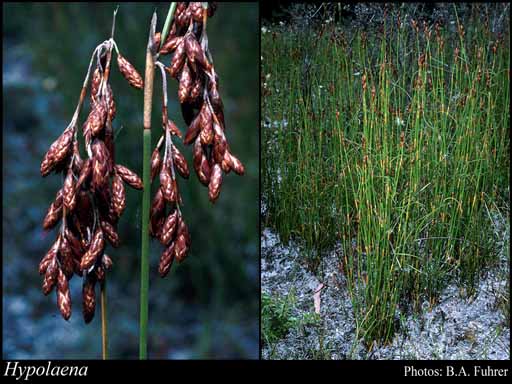- Reference
- Prodr.Fl.Nov.Holland. 251 (1810)
- Name Status
- Current







Scientific Description
Family Restionaceae.
Habit and leaf form. Herbs; evergreen. Switch-plants; with the principal photosynthesizing function transferred to stems (culms). Leaves well developed, or much reduced (the blade being much reduced or absent). Perennial. Young stems cylindrical, or flattened (erect to sinuose, smooth to striate); not breaking easily at the nodes. Stem internodes solid, or hollow. Rhizomatous. Helophytic, or mesophytic. Leaves alternate; distichous, or spiral; leathery, or membranous; sessile; sheathing (and more or less reduced to the sheaths). Leaf sheaths with free margins (appressed, persistent). Leaves simple; with a persistent basal meristem, and basipetal development. Vegetative anatomy. Plants with silica bodies. Leaf anatomy. Leaf blade epidermis conspicuously differentiated into ‘long’ and ‘short’ cells, or without differentiation into ‘long’ and ‘short’ cells. Guard-cells not ‘grass type’, or ‘grass type’. Stem anatomy. Secondary thickening absent.
Reproductive type, pollination. Fertile flowers functionally male, or functionally female. Unisexual flowers present. Plants dioecious. Female flowers with staminodes, or without staminodes. Male flowers with pistillodes, or without pistillodes. Floral nectaries absent (nectaries absent). Anemophilous.
Inflorescence and flower features. Flowers aggregated in ‘inflorescences’; in ‘spikelets’. Inflorescences scapiflorous, or not scapiflorous; terminal; male and female inflorescences dissimilar. Flowers bracteate; bracteolate, or ebracteolate; cyclic. Perigone tube absent. Perianth of ‘tepals’; members (5–)6; 2 -whorled; isomerous, or anisomerous; sepaloid. Fertile stamens present, or absent (when female). Androecium 3. Androecial members free of the perianth; free of one another; 1 -whorled. Androecium exclusively of fertile stamens. Stamens 3; remaining included (mostly), or becoming exserted; oppositiperianthial (opposite the inner perianth members). Anthers dorsifixed; versatile, or non-versatile; dehiscing via longitudinal slits; introrse, or latrorse; bisporangiate, or tetrasporangiate; appendaged, or unappendaged. Pollen shed as single grains. Fertile gynoecium present, or absent (male flowers). Gynoecium 2–3 carpelled. The pistil 1 celled. Carpels isomerous with the perianth, or reduced in number relative to the perianth. Gynoecium syncarpous; synovarious, or synstylovarious; superior. Ovary unilocular; 1 locular; sessile to stipitate. Gynoecium stylate. Styles 2, or 3; partially joined. Ovules in the single cavity 1; funicled, or sessile; pendulous; non-arillate; orthotropous.
Fruit and seed features. Fruit non-fleshy; indehiscent; a nut (smooth or pitted, shed with thickened fleshy stalk, perianth, bracts and subtending glume or (in one species) the complete compound spikelet is dispersed); 1 seeded. Seeds copiously endospermic. Embryo weakly differentiated. Seedling. Hypocotyl internode absent. Mesocotyl absent. Seedling collar not conspicuous. Cotyledon hyperphyll elongated; assimilatory; more or less circular in t.s. Coleoptile absent. Seedling cataphylls absent. First leaf centric. Primary root ephemeral.
Additional characters Perianth of male flowers of ‘tepals’; (5–)6 (the outer 2–3 keeled, the inner flat or concave). Perianth of female flowers of ‘tepals’; 6. Stems glabrous, or pubescent (with ‘fan-hairs’); branched. Male spikelets 1-flowered to many-flowered (pendulous or sessile on short axillary branchlets). Female spikelets 1-flowered. Caespitose, or not caespitose. Female spikelets compound (with small bracts between the flower and subtending glume) (with 1–2 bracts on the stalk of the flower, uppermost glume fertile only). Pericarp woody.
Taxonomic Literature
- Briggs, Barbara G.; Johnson, L. A. S. 2004. New Western Australian species of Hypolaena (Restionaceae) and a new section.
- Wheeler, Judy; Marchant, Neville; Lewington, Margaret; Graham, Lorraine 2002. Flora of the south west, Bunbury, Augusta, Denmark. Volume 1, introduction, keys, ferns to monocotyledons. Australian Biological Resources Study.. Canberra..
- Meney, K. A.; Pate, J. S.; Dixon, K. W. 1996. New species of Restionaceae from Western Australia.